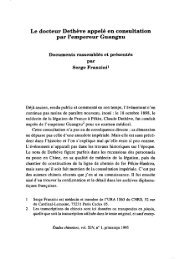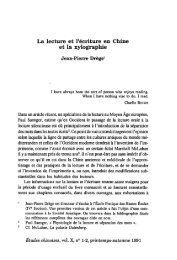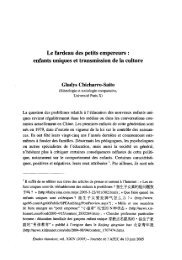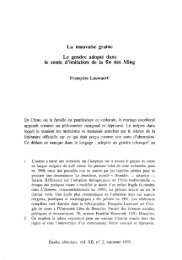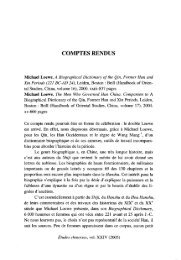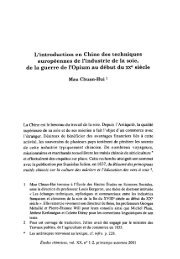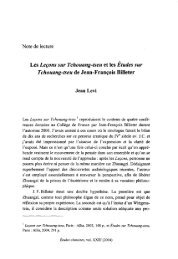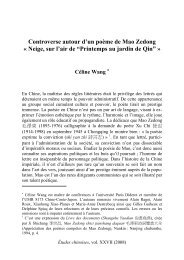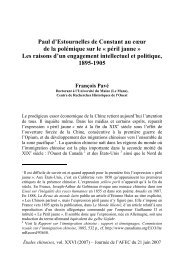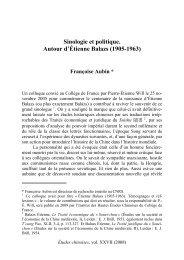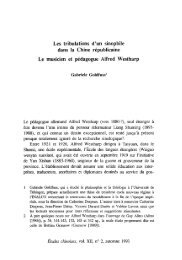Les outils agricoles dans la Chine du xive siècle d'après le ... - AFEC
Les outils agricoles dans la Chine du xive siècle d'après le ... - AFEC
Les outils agricoles dans la Chine du xive siècle d'après le ... - AFEC
Create successful ePaper yourself
Turn your PDF publications into a flip-book with our unique Google optimized e-Paper software.
<strong>Les</strong> <strong>outils</strong> <strong>agrico<strong>le</strong>s</strong> <strong>dans</strong> <strong>la</strong> <strong>Chine</strong> <strong>du</strong> xiV <strong>sièc<strong>le</strong></strong><br />
Résumé<br />
Olivier GUYONVARCH : <strong>Les</strong> <strong>outils</strong> <strong>agrico<strong>le</strong>s</strong> <strong>dans</strong> <strong>la</strong> <strong>Chine</strong> <strong>du</strong> xtv e <strong>sièc<strong>le</strong></strong> <strong>d'après</strong><br />
<strong>le</strong> Nongshu de Wang Zhen<br />
Cet artic<strong>le</strong> est une tra<strong>du</strong>ction partiel<strong>le</strong> et commentée des chapitres (juan) regroupant<br />
<strong>le</strong>s <strong>outils</strong> aratoires <strong>dans</strong> <strong>le</strong> Traité agrico<strong>le</strong> de Wang Zhen (xiv c <strong>sièc<strong>le</strong></strong>).<br />
L'approche n'est pas philologique ni littéraire, mais résolument technique. L'auteur<br />
s'intéresse à <strong>la</strong> pertinence <strong>du</strong> texte <strong>du</strong> point de vue de l'agronomie et au<br />
regard des connaissances actuel<strong>le</strong>s. <strong>Les</strong> <strong>outils</strong> retenus ici sont <strong>le</strong>s plus représentatifs<br />
et <strong>le</strong>s plus intéressants pour <strong>le</strong> <strong>le</strong>cteur non-spécialiste : <strong>la</strong> charrue, pour <strong>le</strong><br />
<strong>la</strong>bour ; <strong>le</strong>s houes, herses et rou<strong>le</strong>aux, pour <strong>la</strong> préparation <strong>du</strong> lit de semences ;<br />
<strong>le</strong> semoir ; <strong>le</strong>s houes et râteaux, pour <strong>le</strong> désherbage ; <strong>le</strong>s couteaux, faucil<strong>le</strong>s et faux<br />
armées, pour <strong>la</strong> récolte. Leur description donne ainsi accès à l'univers technique<br />
<strong>du</strong> paysan chinois. Par ail<strong>le</strong>urs, <strong>le</strong> texte nous éc<strong>la</strong>ire sur <strong>la</strong> spécialisation de<br />
l'outil<strong>la</strong>ge et sur ses modes d'utilisation selon qu'on se trouve en zone de culture<br />
sèche ou en zone de rizière inondée.<br />
Abstract<br />
Olivier GUYONVARCH : Agricultural Tools in Fourteenth-Century China in the<br />
Light of Wang Zhen's Nongshu<br />
This paper is a partial and annotated trans<strong>la</strong>tion of the chapters (juan) describing<br />
agricultural tools in the Agricultural Treatise of Wang Zhen. This study is not<br />
philological or litterary, but resolutely technical. The author is dealing with<br />
agronomical re<strong>le</strong>vance of the text, compared with présent know<strong>le</strong>dge. The tools<br />
that are chosen are the most représentative and of the most interest for nonspecialist<br />
readers: the plow for plowing; hoes, harrows, and rolls to prépare the<br />
seed-bed; the drill; small hoes and rakes for weeding; knifes, scythes, and crad<strong>le</strong>scythes<br />
for harvesting. Readers hâve thus an access to the technical environment<br />
of the <strong>Chine</strong>se peasanL In other respect, the text présents c<strong>le</strong>arly the specialization<br />
of the tools and the way of using them, according as they are used in dry farming<br />
or in irrigated paddy-fields.<br />
49



